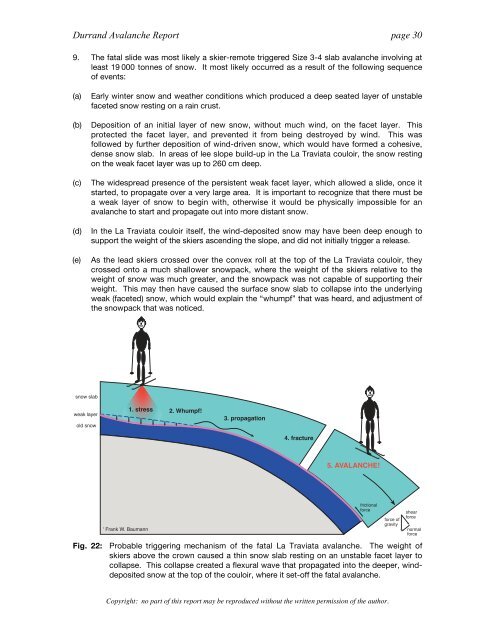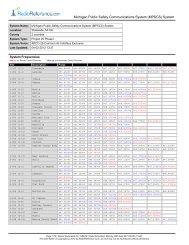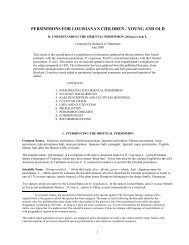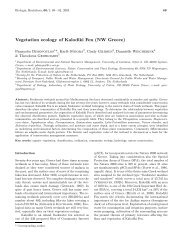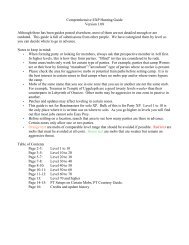Analysis of the Durrand Glacier Avalanche Accident
Analysis of the Durrand Glacier Avalanche Accident
Analysis of the Durrand Glacier Avalanche Accident
You also want an ePaper? Increase the reach of your titles
YUMPU automatically turns print PDFs into web optimized ePapers that Google loves.
<strong>Durrand</strong> <strong>Avalanche</strong> Report page 30<br />
9. The fatal slide was most likely a skier-remote triggered Size 3-4 slab avalanche involving at<br />
least 19 000 tonnes <strong>of</strong> snow. It most likely occurred as a result <strong>of</strong> <strong>the</strong> following sequence<br />
<strong>of</strong> events:<br />
(a) Early winter snow and wea<strong>the</strong>r conditions which produced a deep seated layer <strong>of</strong> unstable<br />
faceted snow resting on a rain crust.<br />
(b) Deposition <strong>of</strong> an initial layer <strong>of</strong> new snow, without much wind, on <strong>the</strong> facet layer. This<br />
protected <strong>the</strong> facet layer, and prevented it from being destroyed by wind. This was<br />
followed by fur<strong>the</strong>r deposition <strong>of</strong> wind-driven snow, which would have formed a cohesive,<br />
dense snow slab. In areas <strong>of</strong> lee slope build-up in <strong>the</strong> La Traviata couloir, <strong>the</strong> snow resting<br />
on <strong>the</strong> weak facet layer was up to 260 cm deep.<br />
(c) The widespread presence <strong>of</strong> <strong>the</strong> persistent weak facet layer, which allowed a slide, once it<br />
started, to propagate over a very large area. It is important to recognize that <strong>the</strong>re must be<br />
a weak layer <strong>of</strong> snow to begin with, o<strong>the</strong>rwise it would be physically impossible for an<br />
avalanche to start and propagate out into more distant snow.<br />
(d) In <strong>the</strong> La Traviata couloir itself, <strong>the</strong> wind-deposited snow may have been deep enough to<br />
support <strong>the</strong> weight <strong>of</strong> <strong>the</strong> skiers ascending <strong>the</strong> slope, and did not initially trigger a release.<br />
(e) As <strong>the</strong> lead skiers crossed over <strong>the</strong> convex roll at <strong>the</strong> top <strong>of</strong> <strong>the</strong> La Traviata couloir, <strong>the</strong>y<br />
crossed onto a much shallower snowpack, where <strong>the</strong> weight <strong>of</strong> <strong>the</strong> skiers relative to <strong>the</strong><br />
weight <strong>of</strong> snow was much greater, and <strong>the</strong> snowpack was not capable <strong>of</strong> supporting <strong>the</strong>ir<br />
weight. This may <strong>the</strong>n have caused <strong>the</strong> surface snow slab to collapse into <strong>the</strong> underlying<br />
weak (faceted) snow, which would explain <strong>the</strong> “whumpf” that was heard, and adjustment <strong>of</strong><br />
<strong>the</strong> snowpack that was noticed.<br />
snow slab<br />
weak layer<br />
old snow<br />
' Frank W. Baumann<br />
1. stress 2. Whumpf!<br />
3. propagation<br />
4. fracture<br />
5. AVALANCHE!<br />
frictional<br />
force<br />
Fig. 22: Probable triggering mechanism <strong>of</strong> <strong>the</strong> fatal La Traviata avalanche. The weight <strong>of</strong><br />
skiers above <strong>the</strong> crown caused a thin snow slab resting on an unstable facet layer to<br />
collapse. This collapse created a flexural wave that propagated into <strong>the</strong> deeper, winddeposited<br />
snow at <strong>the</strong> top <strong>of</strong> <strong>the</strong> couloir, where it set-<strong>of</strong>f <strong>the</strong> fatal avalanche.<br />
Copyright: no part <strong>of</strong> this report may be reproduced without <strong>the</strong> written permission <strong>of</strong> <strong>the</strong> author.<br />
force <strong>of</strong><br />
gravity<br />
shear<br />
force<br />
normal<br />
force


